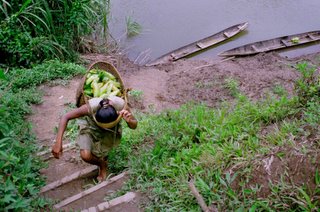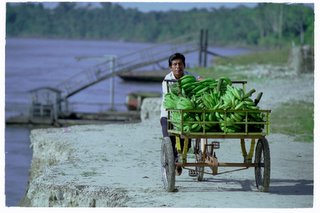

Most of the Aguaruna survive through subsistence farming. With an average per capita income of only US $34, they are unable to buy much food, and must grow or catch their meals. 80% of the Aguaruna diet consists of carbohydrates, so malnutrition is common. Hunting and fishing are practiced by men using the traditional methods, and have great cultural significance for the Aguaruna, but they do not provide nearly as much sustenance as agriculture and domesticated animals.
The Aguaruna mainly grow plantain, maize, and yucca. Plantain is the main cash crop, one of the few viable exports of the region, but yucca is what feeds the Aguaruna. Yucca is an essential part of not only the diet, but of the culture as well. It is consumed daily by the Aguaruna, both as a staple food, and as a beverage, masato. Masato is a beer made by fermenting yucca. It is an intoxicating drink, much valued as a social lubricant. It makes parties and festivals lively, relaxing inhibitions. It is common for couples to form after meeting at village socials while under the influence of masato.
Traditionally Aguaruna women are in charge of gardening and farming. A woman’s standing in her household and in the community is related to her horticultural abilities. This is rooted in the Aguaruna mythology of Nuguki, the “earth mother” who is said to reside within the soil. The following story from the book “Tsewa’s Gift” by Michael Brown is about the Aguaruna's first encounter with Nugkui.
Long ago, the ancestors had no cultivated plants or clay pots, and had to live on a diet of mashed balsa wood cooked in their armpits. Then one day a woman saw peeled yucca skins floating down the river, and followed its trail until she saw Nugkui along the riverbank. The woman wanted Nuguki to return home with her to provide food for her hungry family, but Nuguki declined and instead sent her daughter. Once in her new home Nuguki’s daughter continued to provide an abundance of beautiful food and clay cooking pots, until one day some mischievous children made her summon fierce animals for their entertainment. The children however, became frightened of the animals and threw ash into the daughter’s eyes. So abused, she fled and hid inside the stem of a bamboo plant. Later, a woman from the house found the daughter and began to kick her. In an attempt to escape she crawled into the woman’s anus, which is why humans are plagued with intestinal gas today. After the daughter disappeared, the people were forced to go back to their previous depressed state. Nuguki however, took pity on them and appearing in a woman’s dream directed them to a field of infant plants that were then cultivated and used to feed the people.
Masato
Making masato is easy:
Boil yucca over an open flame until soft. Remove from heat and drain excess water. Mash the boiled yucca with a wooden spoon. Chew the mash and spit it into a vat. Mix with water and let sit for two days.
Enjoy!
No comments:
Post a Comment